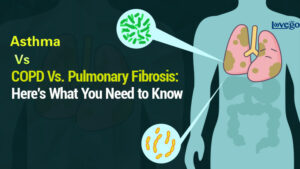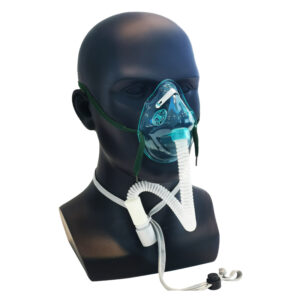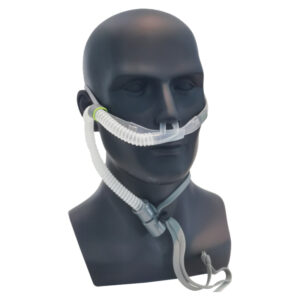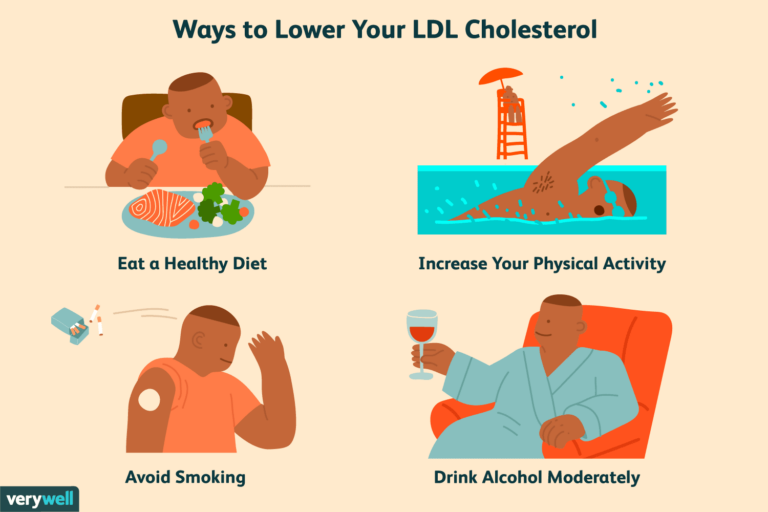
If you or your loved one have COPD, you may be familiar with the term hypoxia. To better understand how hypoxia impacts your body organs and tissues, including the heart, let’s first talk about how COPD can cause it.
COPD and hypoxia
In the body, oxygen goes into the lungs and is carried by the alveoli into the blood. The oxygenated blood then travels to various body organs and tissues, which all need oxygen to function well. In lung damage due to COPD, the lungs may not be able to take in enough oxygen. Thus, blood from the lungs may not be able to supply enough oxygen to body organs and tissues, causing hypoxia.
Some of the most common symptoms of hypoxia include:
Note that these symptoms can vary from person to person. Severe hypoxia can be very harmful, so seek medical attention immediately.
Hypoxia and your heart
One of the most important organs affected by a lack of oxygen is the heart. The heart muscle, which needs oxygen to keep it pumping, is markedly sensitive to fluctuations in oxygen levels. Lungs that are damaged and do not function well make it more difficult for the heart muscle to get enough oxygen. This is one of the reasons why COPD is often associated with heart illnesses.
Acute or short-term hypoxia causes an increase in heart rate along with mild hypertension. This is due to the reaction of certain physiologic mechanisms that control heart rate and regulate respiratory activity to maintain gas concentrations in the body.
In the long term, however, hypoxia may cause damage to the heart and circulation. One of these conditions is pulmonary hypertension. Pulmonary hypertension is an increased pressure in the pulmonary arteries, which carry blood from the heart to the lungs for oxygenation. The right side of the heart is responsible for pumping blood into the lungs to pick up oxygen. This oxygenated blood then travels back to the left side of the heart to be pumped to body organs and tissues.
People with long-term hypoxia are prone to vasoconstriction (narrowing) of the pulmonary arteries. This results in the build-up of pressure in these arteries, which causes the right side of the heart to pump harder. Such stress can then cause the heart’s right ventricle to become damaged and weak, and thus unable to pump enough blood into the lungs. This condition can later on lead to right heart failure.
Additionally, a person with COPD may also be predisposed to mild heart failure. Research shows that about 20-70 % of COPD patients develop heart failure. Such a condition may be due in part to increased inflammation in the body along with the damage caused by lack of oxygen in certain tissues.
Can heart illness be prevented in COPD?
The answer is yes, it can! One of the things you can do to protect yourself from heart disease is to work closely with your doctor to create a treatment regimen that prevents COPD from getting worse. Lifestyle changes, like quitting smoking, weight management and regular exercise will also have a big impact. It’s also a good idea to regularly monitor your blood pressure and cholesterol levels. Always follow your medication and oxygen therapy regimens, and talk to your doctor if you experience any changes with your symptoms.

Having a chronic lung condition can be quite a challenge as it has a great impact on one’s quality of life. Chronic obstructive pulmonary disease, or COPD as we know it, along with asthma, are among the more prevalent respiratory conditions. They affect more people compared to pulmonary fibrosis, which most people may not be familiar with.
Though the symptoms of these respiratory conditions may overlap, they are actually very different diseases. Let’s talk about each of them and their differences between each other.
Characteristics of each disease
As you may know, COPD encompasses a number of respiratory conditions including emphysema and chronic bronchitis. As an obstructive disease, it leads to breathing difficulties by causing poor airflow. Patients who have chronic bronchitis have swollen airways due to excessive mucus, while those with emphysema have damaged air sacs (alveoli) that leads to hyperinflated lungs. Most COPD cases have a combination of both these conditions.
On the other hand, asthma is a chronic condition characterized by swelling or inflammation of the airways. This leads to narrowing of the airways and thus, difficulty in breathing.
Pulmonary fibrosis is an entirely different condition where there is a build-up of scar tissue in the lungs. This leads to a thickening of the walls of the lungs, and thus difficulty in expanding, resulting to lack of oxygen intake and shortness of breath.
Supplement:
Within respiratory disease, there are two classifications: obstructive and restrictive. While obstructive respiratory disease is characterized by the difficulty of expelling oxygen, restrictive respiratory disease is defined by the struggle to fully expand the lungs.
In obstructive pulmonary disease, after the lungs are damaged or the airways become narrowed, exhaled air comes out more slowly than normal. This makes it harder to breathe, particularly after strenuous activity or exertion. As the rate of breathing is increased, there is less time to breathe out all the air before the next inhalation, creating the sensation of feeling out of breath.
While in restrictive pulmonary disease, the lungs themselves are restricted from fully expanding. Whether as a result of stiffness of the chest, weak muscles, damaged nerves or internal scarring, restriction of the lungs from expanding creates a similar sensation of breathlessness.
Causes and symptoms
COPD is usually a result of various factors that damage the lungs such as cigarette smoking, inhalation of cigarette smoke, prolonged exposure to lung-damaging chemicals, and other harmful particulate matter. On the other hand, the cause for asthma is unknown, though a risk factor is a genetic predisposition to the disease. Like asthma, pulmonary fibrosis may also be hereditary. Other conditions can also cause pulmonary fibrosis, including infections, various chronic inflammatory conditions (like sarcoidosis and Wegener’s granulomatosis), and exposure to environmental agents like silica, asbestos and hard metal dusts. In cases where the cause is unknown, it is referred to as idiopathic pulmonary fibrosis.
These three conditions usually have overlapping symptoms like coughing, chest tightness, shortness of breath and wheezing. They may worsen with the presence of triggers like dust, strong scents, allergens and environmental pollutants. COPD however, may also occur with other symptoms such as excessive phlegm.
Asthma is the easiest to manage among the three, since symptoms can be severe only when an asthma attack occurs. For both COPD and pulmonary fibrosis, most patients can experience frequent fatigue, a loss of appetite, and difficulty performing daily tasks. This is because, unlike asthma, the symptoms are continuously present and can interfere with daily living.
Treatment
COPD and asthma have similar medications to manage symptoms, such as corticosteroids and bronchodilators. However, the goal of treatment is different. Aside from relieving attacks, asthma treatment and management is intended to suppress chronic inflammation. For COPD, medications are given to reduce symptoms. Asthma effects can be reversed by suppressing inflammation, while COPD effects cannot be reversed.
In this regard, pulmonary fibrosis is similar to COPD. Effects of the disease cannot be reversed but can be slowed down by medications. Treatment for pulmonary fibrosis includes medications like pirfenidone and prednisone, which serve to suppress the immune system to slow down the disease.
Oxygen use
Supplementary oxygen is useful for these various respiratory conditions. For both COPD and pulmonary fibrosis, oxygen therapy is one of the main methods for managing symptoms. Using oxygen can help alleviate fatigue, shortness of breath and can help meet your body’s oxygen needs. Your doctor may prescribe you with oxygen use for a number of hours each day. You may also be told to use oxygen both when performing daily activities and even while sleeping.
For asthma, oxygen therapy is not frequently used. Nebulizers are more commonly used during asthma attacks to help open up the airways and relieve breathing difficulty. Oxygen therapy, however, can be very helpful during asthma attacks. It can help cut out the negative effects of oxygen loss. This is especially useful in patients whose asthma attacks can be life-threatening.
All in all, it’s important to distinguish one respiratory condition from the other. If you’re having the symptoms of a chronic respiratory disease, your doctor can help diagnose which condition it is.

Whether you’re visiting family or going on a vacation with your loved ones, you may be feeling apprehensive of flying with oxygen. Don’t fret though! With our travel tips for flying with oxygen, you’ll surely be prepared enough to get through your flight smoothly.
Things to do before the flight and during the flight
This is the most important step! Talk to your doctor and let them know that you’ll be traveling by air. He’ll ensure that you’re fit to travel and will give you advice on dealing with the higher pressure inside the plane. He may tell you to adjust and increase your flow rate during the flight because of the changes in pressure. He may also prescribe you with additional medications to take if there is an emergency. Additionally, he will give you a medical clearance document to present to the airline staff to show that you’re fit to travel.
When faced with a choice, it’s just practical to consider a direct flight. This saves you from the hassle of towing your concentrator through more than one boarding and disembarking. Additionally, you save precious travel time, which translates to saving precious battery time for your concentrator.
This will give you the chance to ask about their policies for flying with an oxygen concentrator. Take note of the paperwork they may require, such as the aforementioned medical clearance or a letter from your doctor and a prescription for oxygen. Having all of their required documents before the flight will ensure a much smoother boarding process.
If you’re flying to, from, or within the US, take note that the US Federal Aviation Administration (FAA) has a list of approved concentrators. Make sure to check if your equipment is on this list for in-flight use. Other forms of compressed oxygen, like liquid oxygen and tanks are not approved for flying. And if you use LOVEGO portable oxygen concentrators which has external battery, you don’t need to worry much, just carry the machine as the instructions from us.
Having fully charged batteries is strongly advised in case plug-in power isn’t available. Better yet, have another set of spare batteries with you! It’s also a good idea to know how long your battery will last. Various batteries have differing active lengths of time, so knowing yours will keep you well-prepared.
This is especially important when traveling to another country. Try to look up beforehand the type of power outlets used in your destination. Purchasing a suitable adaptor ahead of time will save you from stress and worry.
Pack your meds and supplies in your carry-on bag to have with you at all times. If you have a lot, it’s also a good idea to keep a list and the scheduled times you have to take them. Additionally, having your prescriptions with you is also a safe move, as some airlines ask to see them. Oh, and having your oxygen prescription is a good idea as well! This helps verify the need for you to bring your concentrator on the flight.
You never know when an emergency can arise. This being said, it’s a must that you have contact info for your doctor and your respiratory therapist. They can give you advice and refer you to other health care personnel as well. It’s also a good idea to have the contact details of your oxygen supplier and your home health care representative.
Finally, a couple of days before your flight, call your airline to confirm about your arrangements. This helps remind them as well to have all your needs ready when you arrive for boarding. Such arrangements can include wheelchair set-up, special documentations, and assistance with your concentrator.
10.During the flight, note that please Board the plane first.
All airlines allow individuals with special needs to board the plane first. Boarding the plane before it gets crowded can help you settle in more easily with your oxygen without having to deal with other passengers.
11. Prefer to use pulse dose (if possible).
If your doctor will allow you to use pulse dose during the flight and if your machine has this setting, then do so! Pulse dose can save more on battery life, allowing you to have prolonged use of your equipment.
12. Have your pulse oximeter with you.
All oxygen patients should always have an oximeter with them at all times, even when not traveling. Throughout the flight, check your oxygen levels every once in a while. Various factors, like changes in altitude and pressure, can affect your oxygen saturation. Thus, it’s very important to monitor your oxygen levels during your flight.
Following these tips can help you go through your flight smoothly without any hassle!
Obstructive sleep apnea is caused by a blockage of the airway, usually when the soft tissue in the rear of the throat collapses during sleep. Central sleep apnea is usually observed in patients with central nervous system dysfunction, such as following a stroke or in patients with neuromuscular diseases like amyotrophic lateral sclerosis (ALS, Lou Gehrig’s disease). It is also common in patients with heart failure and other forms of heart, kidney or lung disease.
Often the first signs of OSA are recognized not by the patient, but by the bed partner. Many of those affected have no sleep complaints. The most common signs and symptoms of OSA include:
People with central sleep apnea more often report recurrent awakenings or insomnia, although they may also experience a choking or gasping sensation upon awakening.
Symptoms in children may not be as obvious and include:
If your doctor determines that you have symptoms suggestive of sleep apnea, you may be asked to have a sleep evaluation with a sleep specialist or may order an overnight sleep study to objectively evaluate for sleep apnea.
An HST is not appropriate to be used as a screening tool for patients without symptoms. It’s not used for patients with significant medical problems (such as heart failure, moderate to severe cardiac disease, neuromuscular disease or moderate to severe pulmonary disease). It’s also not used for patients who have other sleep disorders (such as central sleep apnea, restless legs syndrome, insomnia, circadian rhythm disorders, parasomnias or narcolepsy) in addition to the suspected obstructive sleep apnea.
Conservative treatments: In mild cases of obstructive sleep apnea, conservative therapy may be all that is needed.
Mechanical therapy: Positive Airway Pressure (PAP) therapy is the preferred initial treatment for most people with obstructive sleep apnea. With PAP therapy, patients wear a mask over their nose and/or mouth. An air blower gently forces air through the nose and/or mouth. The air pressure is adjusted so that it is just enough to prevent the upper airway tissues from collapsing during sleep. PAP therapy prevents airway closure while in use, but apnea episodes return when PAP is stopped or if it is used improperly. There are several styles, and types of positive airway pressure devices depending on specific needs of patients. Styles and types include:
Mandibular advancement devices: These are devices for patients with mild to moderate obstructive sleep apnea. Dental appliances or oral mandibular advancement devices that help to prevent the tongue from blocking the throat and/or advance the lower jaw forward can be made. These devices help keep the airway open during sleep. A sleep specialist and dentist (with expertise in oral appliances for this purpose) should jointly determine if this treatment is best for you.
Hypoglossal nerve stimulator: A stimulator is implanted under the skin on the right side of the chest with electrodes tunneled under the skin to the hypoglossal nerve in the neck and to intercostal muscles (between two ribs) in the chest. The device is turned on at bedtime with a remote control. With each breath, the hypoglossal nerve is stimulated, the tongue moves forward out of the airway and the airway is opened.
Surgery: Surgical procedures may help people with obstructive sleep apnea and others who snore but don’t have sleep apnea. Among the many types of surgeries done are outpatient procedures. Surgery is for people who have excessive or malformed tissue obstructing airflow through the nose or throat, such as a deviated nasal septum, markedly enlarged tonsils or small lower jaw with an overbite that causes the throat to be abnormally narrow. These procedures are typically performed after sleep apnea has failed to respond to conservative measures and a trial of CPAP. Types of surgery include:



Cholesterol is a type of lipid. It’s a waxy, fat-like substance that your liver produces naturally. It’s vital for the formation of cell membranes, certain hormones, and vitamin D.
Cholesterol doesn’t dissolve in water, so it can’t travel through your blood on its own. To help transport cholesterol, your liver produces lipoproteins.
Lipoproteins are particles made from fat and protein. They carry cholesterol and triglycerides, another type of lipid, through your bloodstream. The two major forms of lipoprotein are low-density lipoprotein (LDL) and high-density lipoprotein (HDL).
LDL cholesterol is any cholesterol carried by low-density lipoproteins. If your blood contains too much LDL cholesterol, you may be diagnosed with high cholesterol. Without treatment, high cholesterol may lead to many health issues, including heart attack and stroke.
High cholesterol rarely causes symptoms in the beginning. That’s why it’s important to get your cholesterol levels checked on a regular basis.
High cholesterol symptoms
In most cases, high cholesterol is a “silent” condition. It typically doesn’t cause any symptoms. Many people don’t even realize they have high cholesterol until they develop serious complications, such as a heart attack or stroke.
That’s why routine cholesterol screening is important. If you’re 20 years or older, ask your doctor if you should have routine cholesterol screening.
Causes of high cholesterol
Eating too many foods that are high in cholesterol, saturated fats, and trans fats may increase your risk of developing high cholesterol. Living with obesity can also increase your risk. Other lifestyle factors that can contribute to high cholesterol include inactivity and smoking.
Your genetics can also affect your chances of developing high cholesterol. Genes are passed down from parents to children. Certain genes instruct your body on how to process cholesterol and fats. If your parents have high cholesterol, you may be at a greater risk of having it too.
Other health conditions, such as diabetes and hypothyroidism, may also increase your risk of developing high cholesterol and related complications.
LDL cholesterol, or “bad cholesterol”
LDL cholesterol is often called “bad cholesterol.” It carries cholesterol to your arteries. If your levels of LDL cholesterol are too high, it can build up on the walls of your arteries.
This buildup is also known as cholesterol plaque. This plaque can narrow your arteries, limit your blood flow, and raise your risk of blood clots. If a blood clot blocks an artery in your heart or brain, it can cause a heart attack or stroke.
HDL cholesterol, or “good cholesterol”
HDL cholesterol is sometimes called “good cholesterol.” It helps return LDL cholesterol to your liver to be removed from your body. This helps prevent cholesterol plaque from building up in your arteries.
When you have healthy levels of HDL cholesterol, it can help lower your risk of blood clots, heart disease, and stroke.
Triglycerides, a different type of lipid
Triglycerides are another type of lipid. They’re different from cholesterol. While your body uses cholesterol to build cells and certain hormones, it uses triglycerides as a source of energy.
When you eat more calories than your body can use right away, it converts those calories into triglycerides. It stores triglycerides in your fat cells. It also uses lipoproteins to circulate triglycerides through your bloodstream.
If you regularly eat more calories than your body can use, your triglyceride levels may become too high. This can raise your risk of several health problems, including heart disease and stroke.
Your doctor can use a simple blood test to measure your triglyceride level, as well as your cholesterol levels.
Getting your cholesterol levels checked
If you’re 20 years or older, the American Heart Association recommends getting your cholesterol levels checked at least once every 4 to 6 years. If you have a history of high cholesterol or other risk factors for cardiovascular disease, your doctor may encourage you to get your cholesterol levels tested more often.
Your doctor can use a lipid panel to measure your total cholesterol level, as well your LDL cholesterol, HDL cholesterol, and triglyceride levels. Your total cholesterol level is the overall amount of cholesterol in your blood. It includes LDL and HDL cholesterol.
If your levels of total cholesterol or LDL cholesterol are too high, your doctor may diagnose you with high cholesterol. High cholesterol can be dangerous when your LDL levels are too high and your HDL levels are too low.
Recent guidelines for healthy cholesterol levels
Your body needs some cholesterol to function properly, including some LDL. But if your LDL levels are too high, it can raise your risk of serious health problems.
Under the new guidelines, in addition to your cholesterol levels, treatment recommendations analyze other risk factors for heart disease, such as family history and other health issues. The guidelines use all these factors to consider a person’s overall chance of developing complications during the next 10 years.
Risk factors for high cholesterol
You may be at a higher risk of developing high cholesterol if you:
People of all ages, genders, and ethnicities can have high cholesterol.
Without treatment, high cholesterol can cause plaque to build up in your arteries. Over time, this plaque can narrow your arteries. This condition is known as atherosclerosis.
Atherosclerosis is a serious condition. It can limit the flow of blood through your arteries. It also raises your risk of developing dangerous blood clots.
Atherosclerosis can result in many life threatening complications, such as:
High cholesterol can also create a bile imbalance, raising your risk of gallstones. See the other ways that high cholesterol can impact your body.
How to lower cholesterol
If you have high cholesterol, your doctor may recommend lifestyle changes to help lower it. For instance, they may recommend changes to your diet, exercise habits, or other aspects of your daily routine. If you smoke, they will likely advise you to quit.
Your doctor may also prescribe medications or other treatments to help lower your cholesterol levels. In some cases, they may refer you to a specialist for more care.
Lowering cholesterol by diet
To help you achieve and maintain healthy cholesterol levels, your doctor may recommend changes to your diet.
For example, they may advise you to:
Foods that are high in cholesterol, saturated fats, or trans fats include:
Eating fish and other foods that contain omega-3 fatty acids may also help lower your LDL levels. For example, salmon, mackerel, and herring are rich sources of omega-3s. Walnuts, almonds, ground flaxseeds, and avocados also contain omega-3s.
Medications
In some cases, your doctor might prescribe medications to help lower your cholesterol levels. Statins are the most commonly prescribed medications for high cholesterol. They block your liver from producing more cholesterol.
Examples of statins include:
Your doctor may also prescribe other medications for high cholesterol, such as:
Some products contain a combination of drugs to help decrease your body’s absorption of cholesterol from foods and reduce your liver’s production of cholesterol. One example is a combination of ezetimibe and simvastatin (Vytorin).
How to prevent high cholesterol
You can’t control the genetic risk factors for high cholesterol. However, lifestyle factors can be managed. To lower your risk of developing high cholesterol:
Follow your doctor’s recommendations for routine cholesterol screening. If you’re at risk of high cholesterol or coronary heart disease, they will likely encourage you to get your cholesterol levels tested on a regular basis.